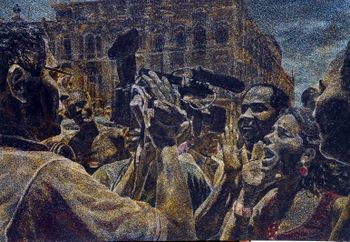DPM Gallery,
Oct 01, 2008 - Nov 05, 2008
Guayaquil-Miami, Ecuador
upcoming
by Rodolfo Kronfle
The first reaction to Saidel Brito’s most recent series, Nacidos Vivos [Born Alive], is the urge created in the viewer to establish with precision which events are responsible for the gathering of the crowds depicted in some of the paintings, or to find the particular significance of landscapes reproduced in others. Paradoxically, no regarding information is provided allowing a kind of anonymity to be withheld by these images -at least until further confrontation with the Cuban social and historical context that is behind each painting(1) -an anonymity, though, clearly familiar with the historical and media conventions used to represent masses. This should lead us to make connections with the artist’s fundamental concerns: "they’re stories and images emptied from their contents as time goes by... of spaces that have vanished in ideological terms or those upon which ideological ghosts seem to be haunting...it deals with memory’s fragility as well as with shifting signs and the emptiness of those signs: geographical, objective, literary in their relation to historical events, information and traces left in museums, in the collective memory and in the physical space where they took place." His work, then, emerges as a reflection on those historical places, and events at a universal level, seeking to point out the way these imaginaries start losing or go on to change their symbolic connotations (for example: Playa Girón, turned into a leisure tourist spot), or on how the echoing voices from their past are no more than spectral presences -if any- in the present. In Brito’s own words "the idea was to go back to the old role of the artist representing particular events, although it implies the paradox of these events having been either stripped by mass media or silenced by time or by the new uses of those spaces". The work also preserves conceptual features present throughout almost all of Brito’s production: Word playing or the use of popular language to benefit from its double meanings, as the series’ title suggest(2); the drive towards experimentation and the "invention" of techniques that may contribute to enhance the work’s contents, that in turn generate our wondering as to how those manual means were achieved, and which consequently derive into a very important -as well as significant- hook for visual seduction (in this series, he experiments with the pyrographer, and uses transparencies and superimpositions); ambiguity as a working principle and as a tool in assisting the semantic enrichment of work produced, as a positive value, as if the artist had become aware of the vast epistemological horizon posed before the contemporary eye to be used productively; the constant integration of a two-way meditation: on art as a tradition filled with principles and prescriptions ready to be disputed, and about History’s sense -with all the media invocations and its discourse constructions- contrasting with the present; and, finally, the interest he shows in the strategic use - the ideological appropriation- of certain repertoires and symbolic archives deemed as "minor" (such is the case of photographs taken mainly from independent Internet sources), though more powerful as context mirrors if compared to creations working restrictedly within the boundaries of the field of art. There are still other links between Nacidos Vivos and his previous work, like the recurrence of two of the leitmotifs that reappear with some frequency: water (wateriness, evoked sea surfaces, etc.) as an existential like problem(3) and the crowds (herds, massive agglomerating, marching, etc.) like binary counterparts of the individual and of free thinking ("I’m interested in the anonymous attitude facing the crowd, because I come from such an idea of "the people", that is, of the masses; that which resides in the
|









